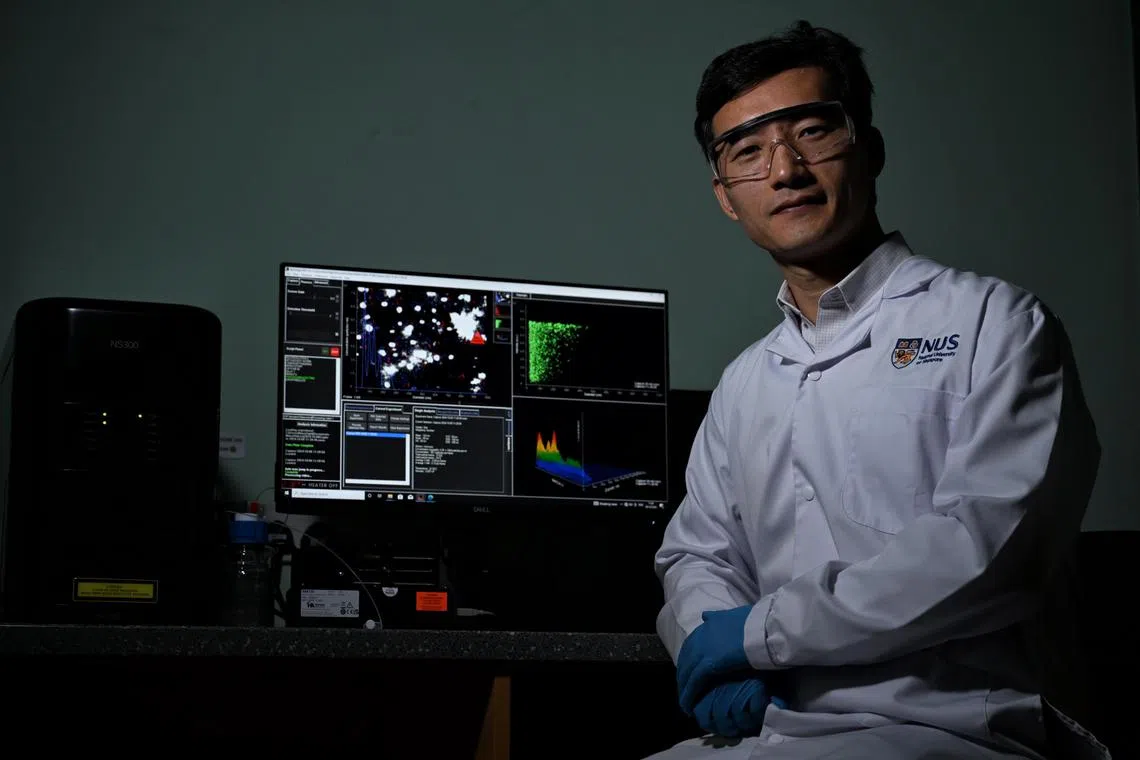New study shows effectiveness of nanoparticles in diagnosing, treating plaque in arteries
Sign up now: Get ST's newsletters delivered to your inbox

Assistant Professor Wang Jiong-Wei using the Nanosight-NS300 in his laboratory.
ST PHOTO: CHONG JUN LIANG
Follow topic:
SINGAPORE - New microscopic particles – less than a thousandth of a millimetre in size – could hold the key to preventing cardiovascular diseases such as coronary heart disease and ischaemic stroke.
Researchers from the NUS Yong Loo Lin School of Medicine (NUS Medicine) have developed a nanoparticle that can diagnose the build-up of plaque in the arteries, otherwise known as atherosclerosis, as well as target atherosclerotic plaques and deliver therapeutic agents.
A nanoparticle is a material with a diameter of between one and 100 nanometres, which is one-billionth of a metre.
These new nanoparticles break down in the acidic environment of atherosclerotic plaques and release gadolinium – a chemical that acts as a contrast agent, improving visualisation for magnetic resonance imaging, or MRI – allowing for real-time imaging of plaque severity.
Additionally, these miniscule particles are able to simultaneously deliver simvastatin, an anti-inflammatory drug that contributes to plaque stabilisation and treatment, thus reducing the risk of cardiovascular events.
The findings were published in nanoscience journal Small in August.
Assistant Professor Wang Jiong-Wei, who led the study, compared the nanoparticles to delivery vehicles, sending both imaging and treatment agents directly to the plaque.
This could eventually relieve patients of the need to see multiple specialists for diagnosis and treatment, saving them both time and money, said the principal investigator at the Nanomedicine Translational Research Programme at NUS Medicine.
Drugs in the nanoparticles will not affect patients whose conditions have improved, Prof Wang told The Straits Times.
For such individuals, the nanoparticles will degrade or pass harmlessly out of the body within a few days, he added.
“If there is no inflammation at all, no plaque on the blood vessels, those nanoparticles will just pass by. That’s the big advantage of nanotechnology,” he said.
The multidisciplinary study was conducted in collaboration with Associate Professor James Kah and Professor Liu Bin, both from the College of Design and Engineering at NUS, and Professor Liu Xiaogang from the chemistry department at the NUS Faculty of Science.
Atherosclerosis, which causes the narrowing of the arteries, is a primary cause of cardiovascular diseases, responsible for more than 17 million deaths worldwide annually, according to the World Health Organisation.
Cardiovascular diseases are a leading cause of mortality in Singapore, accounting for 31 per cent of deaths in 2022.
The use of nanoparticles has several advantages over existing methods for imaging atherosclerotic plaque, which tend to be more invasive and limited in their resolution, in addition to being unable to deliver targeted therapies.
Intravascular ultrasound, for example, uses an ultrasound probe on a catheter inserted into a blood vessel, providing a detailed assessment of the extent and nature of the plaque on the artery walls. It is, however, invasive and can be used only on larger blood vessels, with limited visibility of details.
In comparison, nanoparticles are non-invasive, Prof Wang said.
MRI, used in the study, has the highest-resolution images of blood vessels and plaque structure among existing imaging techniques, with the contrast agent in the nanoparticles providing “remarkable signal enhancement of arterial vessel wall”, according to the researchers.
Additionally, compared with the oral administration of similar doses of simvastatin, nanoparticles can deliver a thousand times more of the drug to the plaque, enhancing its therapeutic efficacy while minimising systemic side effects.
There are currently no treatments that specifically target atherosclerotic plaque, though patients with high risk of cardiovascular diseases are generally prescribed medications that can stabilise plaque, such as statins that lower cholesterol levels.
Simvastatin was chosen to target the inflammatory components of atherosclerosis, said Prof Wang.
While it is still in the proof-of-concept stage, Prof Wang said he hopes to put the nanoparticle into clinical trials within the next three to five years.
Reiterating that the nanoparticles act as vehicles, he said that in future, such particles could include multiple other components for the treatment and diagnosis of other diseases.

